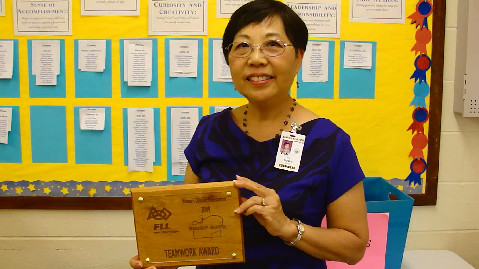
Prinicipal Fay Toyama holding "Teamwork Award" won by the Lehua Lego Leopards Robotics Team recently in competition at Kapolei Middle School. / Photo By: Barry Villamil
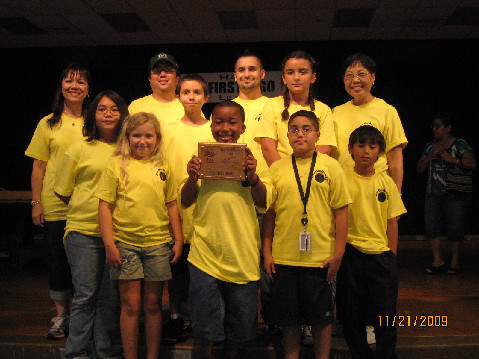
Lehua Lego Leopards Robotics Team earns their way to the State's First Lego League Tournament on December 19, 2009 at the Neal Blaisdell Center. / Photo provide by Lehua Elementary School
Principal, Fay Toyama is in the middle of her 7th year at the helm of Lehua Elementary School located in lower Pearl City. She is an intelligent, problem solving Principal that makes things happen.
Lehua Elementary School is the oldest school in Pearl City, originally opening its doors as Pearl City School back in 1907.
Being Principal at Lehua Elementary comes with the responsibility of remembering and celebrating the schools history as well as facing and overcoming today’s challenges. The current Furlough Friday situation tops the list of challenges to the school.
Lehua Elementary has a high percentage of its student body that represents the Military which means a high turnover and new student rate each year as Military families are stationed in and out of Hawaii.
Principal Toyama has it all under control. She makes sure that new students and their and parents go through a welcome and orientation process that will help make the transition to Lehua Elementary a smooth one and has also implemented a positive behavior support system that monitors and rewards students for good behavior.
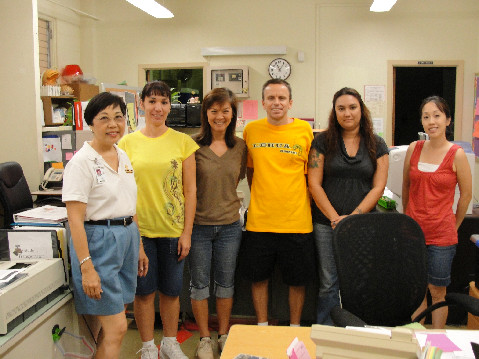
Principal Toyama with her administrative staff / Photo By: Barry Villamil
Also, a key component to the schools success is that Principal Toyama is supported by a dedicated staff, core of volunteers and parents, the Military, and the Pearl City community that have embraced her administrative philosophy. I would like to share that philosophy with you: (pulled from the Lehua Elementary School web site)
• I believe that what is good for the best is good for the rest and I am committed to working towards creating the best in students, teachers, and the learning environment.
• I believe that everyone can learn, and that the art of the professional educator is to connect that tool or strategy with the learner to be successfully empowered.
• I believe that if everyone’s contribution in the school community is valued, a richer learning environment will be created. And, if everyone does his/her share to contribute, a school community of life-long learners will evolve.
• I believe that open, shared communication is a key to building trust, collaboration, and involvement.
• I am able to accept the way things are, but also realize that I can shape the way things will be.
• I would not ask anyone to do what I would not want to do.
In my opinion, if we were able to truly follow Prinicipal Toyama's philosophy message above, all would be well with our public education system as well as the community we live in.
I hope enjoy the following MyPearlCity.com Q&A featuring Lehua Elementary School Principal, Fay Toyama.
Q: What administrative experience did you have before taking over at Lehua Elementary School back in 2003?
A: “I was at Waipahu High School as a Vice Principal for 5 years. Before that I was at Barbers Point Elementary School as Vice Principal for a year.”
Q: When did you first develop your school administrative philosophy?
A: “That was when I went through training and I was in what was called at the time, a cohort group to train to become an administrator. During that year we had to develop a philosophy of educational administration. When I developed my philosophy, of course it was based on how I was as a teacher.
At the end of the program they asked us, “Do you still have the same philosophy?” I realized that I still did. It was a carry over from my years of being an educator before going in to administration.”
Q: You started your teaching career at Waialua Intermediate School back in 1972. What was it like teaching on the North Shore?
A: “I loved it. I worked under Gordon Kuwada who was the Principal at the time. There were teacher cottages out there. At that time there was a mixture of people from the mainland and of course the local population who lived out there or commuted there. I happened to be from Wahiawa so my first few years I was commuting.”
Q: How about the atmosphere teaching in a small rural school community?
A: “It has a nice, warm feeling. Everybody knows each other, so once you start working in the community it’s wonderful. It’s a plantation community. The students all know each other and as you start to get to know the families, you make all these connections and they’re very nice people. My parents were raised at Waipahu Plantation so for me it was just like one plantation community to another.”
Q: Where was your next teaching assignment after Waialua Intermediate?
A: “I left for a few years and I went to Aiea High School. Then I went back to Waialua and the second time was when the plantation was closing down. It was a different atmosphere. Part of it was giving students options. We had the students study what are the different options for the community once the plantation closes down. They actually researched, should they go into farming certain things? Should they raise certain things? Should they do certain things? It was really good research that they had to do and then present it to the community.”
Q: So the students were able to help guide and prepare the Waialua community for the future?
A: “It was a very good learning experience. That’s something like what we are trying to do now for all students and their high school senior project, what we call the service learning. They have to figure out what the problem is, research it, and then present solutions and also present it to the community.”
Q: You have a student population dominated by military students that transition in and out of Lehua Elementary each year. How do you address the task of blending new students with returning students?
A: “Well we have a very diverse population. The students all have to learn to get along with each other. So we have three school rules, very simple rules. I take care of myself, I can take of each other and I can take care of this place. Because of our diverse population, we really work with this, not only our general learner outcomes. One of the general learner outcomes is to work as a team.
We try and get all of our students on the same page, because it’s a constantly changing population, at the beginning of the year we really present these ideas, what these rules mean, and what they should be doing at every part of the school. So we have a behavior matrix that we go over with all the students.”
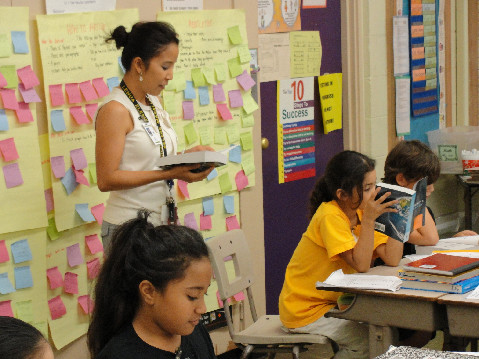
Lehua Elementary School students hard at work / Photo By: Barry Villamil
Q: How does the behavior matrix work?
A: “From the first day of school we teach them. It’s getting them to learn the rules so that we won’t have as many behavioral problems. We use this for rewards. When we catch the students being good, like taking care of this place by picking up trash or helping someone else, they get an “I Care Pass” reward. That’s how they learn. On Tuesday and Thursday, they turn them in for a prize during morning recess. For a bigger prize at the end of the quarter they need to have 25. This is an incentive for them to be good.
It’s called our Positive Behavior Support Program. That has been our strongest program to keep students from being referred.
The first year I came here it was even if they had done it, it was like a new group of students. When I started looking at our stats of how many new students we have every year, about four years ago, it was 54% who were new to our school. The next year it went up to 55% -56%. Last year, it was 61% of students were new. So every year it’s like starting a new school with new students and new parents.”
Q: What percentage are Military students and how well do they adapt to your programs?
A: “70% is Military. I think it’s more than 70%. When I first came here it was about 60% Military. As our demographics changed, we found that we couldn’t leave it to chance. We always have to work on our Positive Behavior Support Program. We have a very good program and we always have to think of new ways of giving the kids incentives to behave.”
Q: Are there any other programs to reward the students?
A: “Each classroom has their own where they provide and some students may need more positive remarks than others. They might have a little chart on their table where they are given stars or a happy face. If they earn so many of those at the end of the day, they get a reward or at the end of that block they might have a reward. In some rooms there are chains, where if the student does well they might get a link on the chain. So it depends on the child. It depends on the classroom.”
Q: How is your Teacher retention each year?
A: “It has improved over the past few years. The first year I was here, half the teachers were new. Now we have very few new people coming in every year, so that has improved. Whenever I have a new teacher we have to work with them so they will understand why we do things. I do an orientation for my new teachers or any new staff member. I have them come in for an orientation before school starts so they’ll understand our philosophy and how we do things.”
Q: How are you handling the Furlough Friday crisis?
A: “Well like any other school we are trying to cram in five days of work into four and we’re really tired. We’re very tired, but we’re doing the best that we can on that.”
Q: Your philosophy on receiving a public school education?
A: “I think the public schools are a reflection of our larger community. If you can do well in public school you can do well anywhere in life. That’s been my philosophy. I went to Leilehua High School. I’m a graduate of Leilehua. Half of my classmates were from the Military. It’s nothing new for me. We still keep in touch. We still have our class reunions and they come back.
As far as the public schools, my own children all did well. My daughter is working on the Mainland in advertising and I have two sons who are still living here and are on their own.
Also, as my children were going through public school, I think as a parent, I made sure that they participated in things like band or student council or things that would help them be successful and grow, and that’s what they did. I’m very fortunate for that.”
Q: How closely do you interact with the other schools in the Pearl City District Complex?
A: “As a Complex we work very closely together. We have our meetings and we’re trying to move in the same direction. We are always cognizant of that and of our District initiatives to our state initiatives. We always put that in our academic and financial plan.”
Q: Does Lehua Elementary receive financial support from the Military?
A: “We’re part of “Joint Venture Education Forum” that is an organization set up through Senator Daniel Inouye. It’s funded by Congress and they have about 5 million dollars a year to be divided into different programs for Hawaii schools with a Military population. So every year there are grants available. The funds come out and through Joint Venture Education Forum we write grants or we put in requests and then we receive funding from there. That’s how we’ve been able to survive. If not for that funding I would not be able get all the technology that we have in our school.
We also have funding through the Military Impact Aid. That’s very important to us because we get a special funding for every Military student that we have. When I’ve written up funds for our school when I first came, we did a lot of technology/text book funds. I had to upgrade all of our textbooks so we’re fine now.”
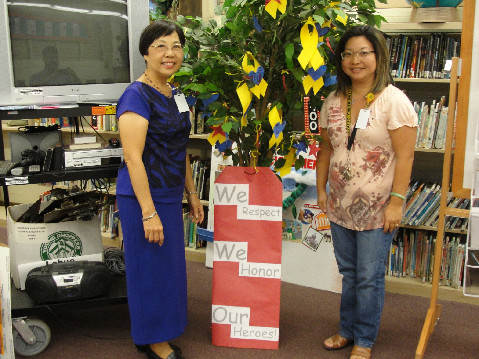
Principal Toyama with school Librarian, Kris Chan / Photo By: Barry Villamil
Q: The Pearlridge Rotary Club recently donated dictionaries to Lehua Elementary School 3rd Graders. How important is the donation each year?
A: “We enjoy that every year from the Rotary. They are always helping us out. That’s something that the 3rd Grade teachers I know, look forward to every year, because that’s somebody else coming in and presenting to the students and sharing with them how important the dictionary is with vocabulary and how learning never ends.
That’s our vision statement: Lehua Elementary, where learning never ends… We always promote that with everything we do.”
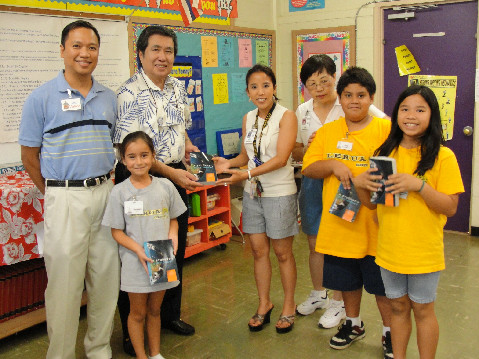
Pearlridge Rotary Club members presenting Lehua Elementary School 3rd Graders with donated Dictionaries / Photo By: Barry Villamil
Q: Have any of the 3rd Graders shared with you anything that they have learned from their new dictionaries?
A: “After school they were showing me the Rotary Code of Ethics and we were talking about that. What it means? I said these are really good questions that you can even ask yourself whenever you make a decision because every morning I have a message from Project Wisdom and I always tell them make it a good choice.
There’s a quote that I tell, a little story, and I tell them, everyday you make a good choice, make a positive choice. We’re always talking about choices here. It just blends in to what the Rotary is doing.”
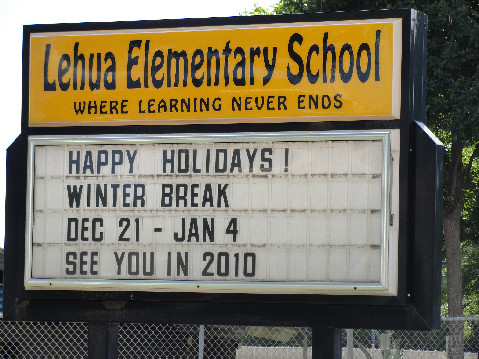
Photo By: Barry Villamil